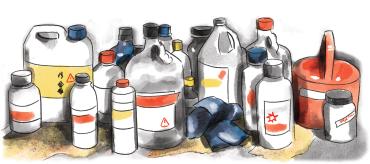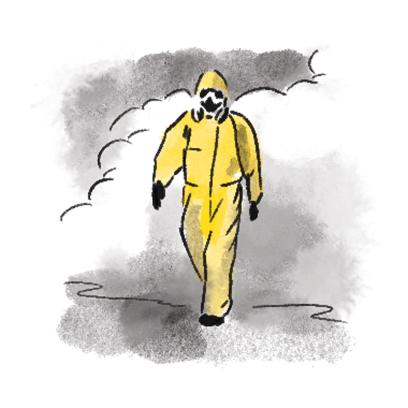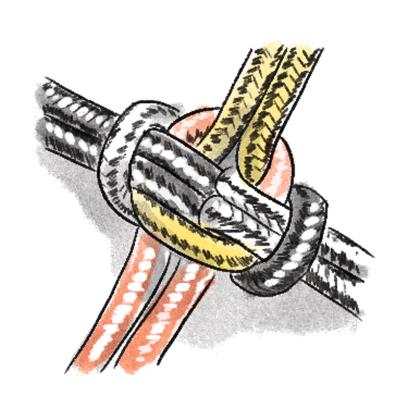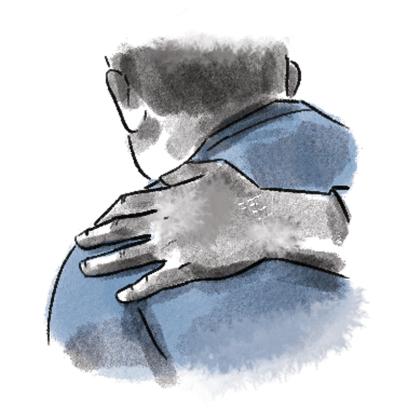Marty Lujan’s death was tragic—and likely preventable. To learn essential lessons for worker protection, we spoke with three occupational medicine experts. Robert “Bob” Harrison, MD, MPH, a specialist in occupational medicine, founded and is senior faculty with the University of California San Francisco Occupational Health Services. He served on the California Occupational Safety and Health Administration Standards Board and also directs the California Department of Public Health’s worker tracking and investigation program. Joseph “Chip” Hughes, MPH, served as deputy assistant secretary for pandemic and emergency response at the Occupational Safety and Health Administration in 2021. For 31 years, he was the director of the National Institute of Environmental Health Sciences Worker Training Program. Currently, he is a senior policy advisor to MDB, Inc. Before retiring, Katherine “Kathy” Kirkland, DrPH, MPH, served as the executive director of the Association of Occupational and Environmental Clinics, where she spent three decades. She also served as an adjunct assistant professor in the Department of Public Health Nursing at the University of North Carolina at Chapel Hill.
For more information and resources on a range of topics, including asbestos and chemical exposure, indoor environmental quality, and safe laboratories, visit aft.org/health-hub. You can also email the health and safety team directly at 4healthandsafety@aft.org.
–EDITORS
EDITORS: How did you get involved in occupational medicine?
BOB HARRISON: When I was a medical student in the late 1970s, I learned about occupational medicine by working with Tony Mazzocchi, who was the national head of safety and health at a chemical workers union.1 Union members at a factory were exposed to several toxic chemicals and were suffering from liver damage—but they didn’t understand what was causing it. The doctors in the area didn’t understand the complex chemicals used in this factory or how they could affect the liver. I researched the problem and worked with the local union to provide training so everyone understood the connection between their liver problems and those toxic chemicals.
After I graduated from medical school, I went to the University of California San Francisco, which at that time had one of the few training programs for doctors in occupational medicine. Now there are about 20 of these programs around the country.2 Once I finished my training, I became a faculty member. Now I train specialists like me—two to three per year—and they diagnose and treat patients with me. My union relationships have been my inspiration in the field. I appreciate being able to make a difference for workers in many different unions.
KATHY KIRKLAND: I got started in 1990 when I became the administrative assistant for the Association of Occupational and Environmental Clinics (AOEC). We had a whopping staff of two and were fortunate to have a very active board of directors—including Dr. Bob Harrison. When the AOEC was formed, the American College of Occupational Medicine was mainly corporate focused and didn’t address environmental issues, though it later became the American College of Occupational and Environmental Medicine, which we at AOEC always like to attribute to AOEC’s influence. The AOEC has always been involved with public health and been pro-worker, as opposed to pro-company.
Occupational medicine remains a very small specialty. This year (2024–25) is the first in which it will be part of the National Resident Matching Program.3 Occupational medicine requires a one-year clinical residency in a clinical specialty and then two years of specialty training.
CHIP HUGHES: I was a student activist searching for a labor- and worker-based career as an organizer. The day after I graduated from college, the United Mine Workers sent me to Harlan County, Kentucky, to support coal miners striking against Duke Power Company as part of the Black Lung Movement. After that, in the mid-1970s, I got involved with a group of people to develop the Brown Lung Association focused on cotton textile workers—they were a forgotten, downtrodden group of people.
Arend Bouhuys, an occupational medicine physician from the Netherlands, came to the United States in 1962 because he wanted to investigate the presence of byssinosis, or cotton dust disease.4 His work became a North Star for documenting a problem that no one was acknowledging. Occupational medicine is like being a disease detective. You can’t see someone’s alveoli being destroyed in their lungs or tumors growing until it’s too late. And even when the disease is undeniable, attributing it to the workplace is difficult. Bouhuys’s studies and our years of working together resulted in an Occupational Safety and Health Administration (OSHA) Cotton Dust Standard in 1978.5
EDITORS: What are some of the challenges of occupational medicine?
KATHY: Traumatic workplace injuries are pretty easy to diagnose, but workplace illnesses and cumulative injuries such as carpal tunnel syndrome are much more difficult. This is where occupational medicine physicians are key because of their in-depth training in epidemiology, ergonomics, and toxicology, including low-dose chronic exposures.
A critical part of being in the occupational health field is making patients aware of their risks on the job. You can’t let them seriously endanger their lives, so you focus on education and supporting workers’ choices. For example, you can’t tell a painter, “Your lead level is too high, so you’re going to have to quit work for however long it takes to get your lead levels down. And in the meantime, I don’t know what you’re going to do for work.” But you can teach painters how to limit their exposures, such as by washing their work clothes separately and using respiratory protection.
In order to get younger physicians interested in occupational medicine, you need leaders, like Bob, who advocate for it. Occupational medicine does not provide a lot of income to a hospital or clinic, and taking a good occupational medicine history requires about 45 minutes. Medicare, Medicaid, and other forms of insurance aren’t set up for that.
Given how few medical schools offer occupational medicine and the payment structure barriers, one challenge is the lack of occupational specialists. In areas with no trained occupational physicians or nurses, workers depend on clinicians who are willing to connect the dots. But physicians typically have 15 minutes per patient—that doesn’t leave time for asking about issues at work. So it’s important for union members to bring information to clinicians. Have several women working in one factory given birth prematurely? Are multiple workers in one section of a plant experiencing headaches? Unions are well-positioned to gather such information and raise red flags. Sometimes there’s a problem, and sometimes these are just coincidences. Clinicians are needed to help figure out whether coworkers are at risk.
BOB: I’ll add that the complexity of occupational medicine is an inherent challenge. If workers are concerned about toxic chemicals, for example, they first need to understand what the toxic chemicals are. Each individual chemical can be toxic or cause harm, and combinations—like the mixtures in many brand-name chemicals—can be even more harmful. Finding out what chemicals are present in the workplace is a right of every worker under an OSHA regulation called the Hazard Communication Standard issued in 1985.6
When it comes to complex chemicals, the amount of available information varies significantly. The Safety Data Sheets (SDS), which are required by OSHA to be available to everybody in the workplace, are a great place to start looking. But sometimes the SDS is incomplete, so the next step is contacting a doctor or a toxicologist who has knowledge of the health effects of those chemicals.
Let’s say somebody’s concerned about a problem with their nervous system; they are experiencing frequent headaches and tingling in their arms and feet that they think might be from nerve damage. They go to their regular doctor and bring the SDS for the chemical they’re working with. Their regular doctor may not know much about that chemical. Even a neurologist may not know—doctors generally have only one or two hours of training in occupational medicine. So, I highly recommend that an occupational specialist gets involved if more investigation is needed. But, as Kathy explained, we don’t have enough specialists.
CHIP: I was nearly 40 when I went to work for the National Institute of Environmental Health Sciences, a federal agency that looks at the way the environment affects our bodies, our organs, our systems, our genes. My focus has been on developing education training programs for workers in hazardous situations, including the Exxon Valdez spill, the World Trade Center cleanup after 9/11, Hurricane Katrina, Ebola, and COVID-19.
It feels like we’ve barely scratched the surface in creating a medical and public health infrastructure that can serve workers in a world so full of hazards. One would think it would be really easy to rally majority support for protecting people who risk their lives on behalf of everybody else. But sadly, that hasn’t been the case.
Occupational medicine takes place in the fraught battleground of labor and management. A lot of the fight around occupational and environmental diseases centers on causation and liability. And in the case of workers’ compensation for occupational diseases, instead of going to the hospital and getting treatment, workers have to file a claim to figure out whether their treatment will be covered by their insurance and whether their harm is compensable. The litigious nature of occupational disease is an impediment to getting the necessary care.
To resolve this, we need a national healthcare system that integrates occupational medicine and environmental medicine. Workers shouldn’t have to hire a lawyer, an industrial hygienist, and an epidemiologist to prove workplace-caused harm in order to be eligible for treatment. Many other wealthy countries, such as Canada7 and England,8 have integrated healthcare systems that cover everyone, so their workers don’t have delays or added costs in accessing care for work-related problems.
KATHY: I agree. If you look at the systems in Sweden9 and France,10 as well as Canada and England, they are so much better than what we have in the United States.11 We have higher infant mortality, higher maternal mortality12—so many issues, and yet our system is not designed to put time and money into preventive care or even basic treatment.13 We need to get away from paying for procedures and start paying for prevention and treatment of chronic disease.
EDITORS: How can unions help protect their members and all workers?
BOB: The most important thing unions can do is ensure workers know their rights. Workers have the right to a healthy and safe workplace under the General Duty Clause of the Occupational Safety and Health Act.14 It covers all safety and health hazards—anything from a machine that has a rotating blade that’s not guarded to a roofer who is not connected by a safety rope, a construction worker on a ladder, or ergonomic hazards (such as from repetition, where doing something over and over again causes wear and tear on muscles, nerves, and tendons and can eventually lead to permanent injury).
Although OSHA requires the employer to measure hazards and correct them immediately, in my view unions ideally would have their own capacity to measure—or at least warn of—hazards. At minimum, unions should bargain to ensure they have a union representative involved in evaluating and correcting hazards.
OSHA was created to protect workers, but it’s important to provide training and support so workers feel safe making complaints. That’s a key role for unions. Under OSHA law, the employer cannot retaliate against somebody for filing an OSHA complaint—and complaints are confidential—but many workers are hesitant and need support.
CHIP: For the last 30 years, I’ve preached that each organization needs to have its own emergency response capacity, which may involve protocols, procedures, plans. It may involve having staff experts to call on, knowing who to call, or at least knowing who knows.
How you prepare your organization to live in our world of risk needs to be something that leadership takes seriously. In the union context, that’s a challenge for the labor movement and for each local. How do you think about health and safety within your organizations—your union and your employer?
KATHY: I’ll add a message for workers: Don’t be afraid to speak up and talk to your colleagues and union steward. See if you share any symptoms or concerns. If you’re a union member, you are fortunate because you can complain to somebody. It’s the undocumented workers who are living hand-to-mouth who have nobody to complain to. And if they do complain, they’re fired.
EDITORS: Let’s turn to Marty Lujan’s tragic death. What lessons should we learn to prevent future tragedies?
BOB: The first step in a situation like this is to intervene at the very beginning—the longer somebody is exposed, the greater their risk. There should be a response plan in place, including a comprehensive inventory of the chemicals someone could be exposed to, whether there are chemicals being used, old chemicals being stored, or new chemicals being ordered.
In addition, there should be an environmental health and safety department that must review each chemical and grant permission for it to be ordered, used, or stored. That department shouldn’t prevent research from being done, but it must prevent students, custodians, janitors, and others from being exposed to those chemicals. There should also be a health and safety committee with a clear reporting system for anyone who has potentially been harmed—and the reporting system should specify who is responsible for responding immediately. If exposure or harm is happening, the health and safety committee must take it seriously and ensure that all other responsible parties take it seriously.
Unions need to advocate and bargain for an effective health and safety committee so that workers know they have a pathway for reporting, their concerns are heard, and the employer will meet its responsibility under OSHA to respond. In some cases, the right thing for the employer to do is contact OSHA to get help addressing the problem. And, if the employer doesn’t do that or otherwise solve the problem, the union or any individual can contact OSHA.
Especially with chemical exposure, as an occupational medicine specialist, I always advise erring on the side of caution. You may not be sure there’s a toxic chemical involved, but stop the exposure and do an investigation. If you have an effective environmental health and safety department and an effective health and safety committee, these investigations can be done quickly. If you don’t have them, then it’s time to take collective action to first stop the potential exposure and then establish these necessary safeguards and procedures.
In April 2025, the Trump administration eliminated most of the scientists and staff at the National Institute for Occupational Safety and Health (NIOSH). This includes funding for the 18 Education and Research Centers around the country that give specialized help in occupational medicine, toxicology, industrial hygiene, and outreach and education. The AFT, along with several other national unions, is suing the Trump administration to restore the funding for NIOSH so that all workers can get the help they need to keep their workplaces safe.
CHIP: I’ve spent my career in chemical emergency response. The worker trainer in me would say that every worker in every workplace should have emergency response preparation—much like what Bob described. Every worker should know not to enter a potentially hazardous site and who to call to begin evaluating the site. No one who’s not a trained professional should respond to a chemical leak in a workplace unless it’s been characterized, meaning that you know what chemicals are involved, how lethal they are, and what protection is needed.
Ideally, workplaces would have someone on staff with the appropriate level of expertise, like an industrial hygienist or an occupational physician or nurse, so that there is some emergency response capacity. But in most cases, employers rely on local fire departments, including volunteer firefighters in rural areas; they often don’t have the expertise or the equipment needed for an adequate response.
Over the past several decades, the United States has developed an infrastructure of trained HAZMAT technicians—think of firefighters in moon suits. But that infrastructure is mainly in urban areas and in big companies. Our chemical emergency response structure across the country is a patchwork.
To improve our national capacity, I think we need three things. One, having the awareness in the workforce of how to protect yourself. Two, having the infrastructure everywhere so that even rural counties have the capacity to act while protecting emergency responders. Three, having the expertise in occupational medicine throughout the country to determine when there are health hazards and to warn people about them.
As we look to the future, we must honor the struggles of those who came before us while building a movement that is bold, inclusive, and adaptive. The fight for worker health is far from over, but with collective action and a commitment to justice, I believe we can create a world where no one has to sacrifice their health for a paycheck.
Endnotes
1. Tony Mazzocchi Center, “About Us: Tony Mazzocchi,” uswtmc.org/about-us/tony-mazzocchi.
2. J. Green-McKenzie et al., “The Future of Occupational and Environmental Medicine,” Journal of Occupational and Environmental Medicine 64, no. 12 (December 2022): e857–e863, acoem.org/acoem/media/News-Library/Future-of-OEM_Final-2022.pdf.
3. American College of Occupational and Environmental Medicine, “ACOEM Announces Participation in NRMP Residency Pathway Match,” August 8, 2024, acoem.org/Press-Center/ACOEM-Announces-Participation-in-NRMP-Residency-Pathway-Match.
4. Nature,“Obituary: Arend Bouhuys,” 281 (October 18, 1979): 615, nature.com/articles/281615a0.pdf.
5. Occupational Safety and Health Administration, “Cotton Dust/Cotton Gins,” US Department of Labor, June 23, 1978, osha.gov/laws-regs/federalregister/1978-06-23.
6. Occupational Safety and Health Administration, “Hazard Communication,” US Department of Labor, November 27, 1985, osha.gov/laws-regs/federalregister/1985-11-27; and Occupational Safety and Health Administration, “Hazard Communication,” US Department of Labor, osha.gov/hazcom.
7. R. Tikkanen et al., “International Health Care System Profiles: Canada,” Commonwealth Fund, June 5, 2020, commonwealthfund.org/international-health-policy-center/countries/canada.
8. R. Tikkanen et al., “International Health Care System Profiles: England,” Commonwealth Fund, June 5, 2020, commonwealthfund.org/international-health-policy-center/countries/england.
9. R. Tikkanen et al., “International Health Care System Profiles: Sweden,” Commonwealth Fund, June 5, 2020, commonwealthfund.org/international-health-policy-center/countries/sweden.
10. R. Tikkanen et al., “International Health Care System Profiles: France,” Commonwealth Fund, June 5, 2020, commonwealthfund.org/international-health-policy-center/countries/france.
11. D. Blumenthal et al., Mirror, Mirror 2024: A Portrait of the Failing U.S. Health System; Comparing Performance in 10 Nations (New York: Commonwealth Fund, September 19, 2024), commonwealthfund.org/publications/fund-reports/2024/sep/mirror-mirror-2024.
12. M. Gunja, E. Gumas, and R. Williams, “U.S. Health Care from a Global Perspective, 2022: Accelerating Spending, Worsening Outcomes,” Commonwealth Fund, January 31, 2023, commonwealthfund.org/publications/issue-briefs/2023/jan/us-health-care-global-perspective-2022.
13. S. Levine et al., “Health Care Industry Insights: Why the Use of Preventive Services Is Still Low,” Preventing Chronic Disease 16 (March 14, 2019), cdc.gov/pcd/issues/2019/18_0625.htm.
14. “What Is the OSHA General Duty Clause?,” OSHA.com (blog), January 12, 2023, osha.com/blog/general-duty-clause.
[Illustrations by Gabriella Trujillo]




